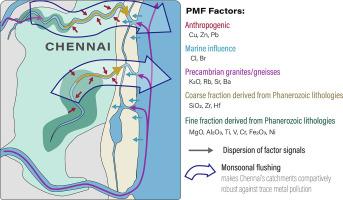应用正矩阵分解法改进河流沉积物中微量元素人为影响评价
IF 8
1区 环境科学与生态学
Q1 ENVIRONMENTAL SCIENCES
引用次数: 0
摘要
金奈是印度东南部的主要工业中心,面临着重大的环境挑战,包括河流沉积物中的微量金属污染。由于没有当地的参考水平,以往对金奈沉积微量金属动力学的研究主要依赖于相对于全球的富集水平。然而,这种方法可能导致误判,因为(a)没有考虑潜在的富集过程,(b)当地背景浓度可能低于全球平均水平,掩盖了真正的富集信号。为了解决这一限制,应用正矩阵分解(PMF)来识别控制元素浓度的过程。然后将结果与依赖全局背景值获得的富集因子(EF)进行比较。用XRF分析了130个河流沉积物样品的元素组成,用激光衍射分析了粒度分布。沉积物以砂质为主,粘土质物质主要分布在阿德亚尔河上游。PMF区分了影响河流沉积物微量元素组成的几个自然因素,即海相影响和沉积物的物源岩性,分别划分为前寒武纪岩性和显生宙岩性的细组分和粗组分。PMF分析证实Cu、Zn、Pb和Cr为人为富集元素。然而,大量的季风排放从河流集水区冲走了细沉积物,使它们主要以沙子为主,这限制了微量金属排放的储存能力。此外,尽管该地区的沉积体系复杂,但PMF成功地区分了不同的烃源岩。相反,EF分析发现SiO2、Cl、TiO2、Cr、Cu、Zn、Br、Y、Zr、Hf和Pb的浓度升高(EF中值>;1). 然而,PMF结果表明,由于自然过程,与地壳背景相比,这些元素中的大多数都是富集的。本文章由计算机程序翻译,如有差异,请以英文原文为准。

Improving the assessment of anthropogenic impact on trace elements in fluvial sediments by applying Positive Matrix Factorization
Chennai, a major industrial hub in southeastern India, faces significant environmental challenges, including trace metal pollution in fluvial sediments. Previous studies on sedimentary trace metal dynamics in Chennai have predominantly relied on enrichment relative to global means, as no local reference level is available. However, this approach may lead to misjudgment because (a) the underlying enrichment processes are not considered, and (b) local background concentrations may be lower than global averages, masking true enrichment signals. To address this limitation, Positive Matrix Factorization (PMF) was applied to identify the processes controlling elemental concentrations. The results were then compared to enrichment factors (EF) obtained by relying on global background values.
A total of 130 fluvial sediment samples were analyzed for their elemental composition using XRF and for grain size distribution using laser diffraction. Sediments were mostly dominated by sand, with significant shares of clayey material being limited to the upper reaches of the Adyar River. PMF differentiated several natural factors driving the trace element composition in the fluvial sediments, namely marine influence and the source lithology of the sediments, which was differentiated into Precambrian lithologies, and the fine and coarse fractions of the Phanerozoic lithologies, respectively. Cu, Zn, Pb, and Cr were confirmed as anthropogenically enriched elements by PMF analysis. However, high monsoonal discharges flush fine sediments from the river catchments, leaving them mainly sand-dominated, which limits storing capacities for trace metal emissions. Furthermore, PMF successfully differentiated distinct source lithologies, despite the complex sedimentary system of the region. In contrast, EF analysis identified SiO2, Cl, TiO2, Cr, Cu, Zn, Br, Y, Zr, Hf, and Pb as having elevated concentrations (median EF > 1). However, most of these elements are enriched compared to crustal backgrounds due to natural processes, as shown by the PMF results.
求助全文
通过发布文献求助,成功后即可免费获取论文全文。
去求助
来源期刊

Science of the Total Environment
环境科学-环境科学
CiteScore
17.60
自引率
10.20%
发文量
8726
审稿时长
2.4 months
期刊介绍:
The Science of the Total Environment is an international journal dedicated to scientific research on the environment and its interaction with humanity. It covers a wide range of disciplines and seeks to publish innovative, hypothesis-driven, and impactful research that explores the entire environment, including the atmosphere, lithosphere, hydrosphere, biosphere, and anthroposphere.
The journal's updated Aims & Scope emphasizes the importance of interdisciplinary environmental research with broad impact. Priority is given to studies that advance fundamental understanding and explore the interconnectedness of multiple environmental spheres. Field studies are preferred, while laboratory experiments must demonstrate significant methodological advancements or mechanistic insights with direct relevance to the environment.
 求助内容:
求助内容: 应助结果提醒方式:
应助结果提醒方式:


